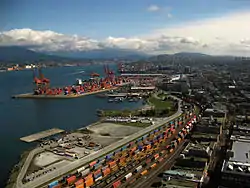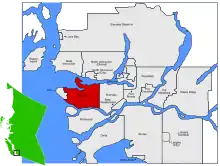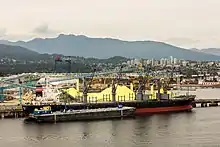Port of Vancouver
The Port of Vancouver is the largest port in Canada and the fourth largest in North America by tonnes of cargo, facilitating trade between Canada and more than 170 world economies. The port is managed by the Vancouver Fraser Port Authority, which was created in 2008 as an amalgamation of the former Port of Vancouver, the North Fraser Port Authority, and the Fraser River Port Authority. It is the principal authority for shipping and port-related land and sea use in the Metro Vancouver region.
| Port of Vancouver | |
|---|---|
 | |
Click on the map for a fullscreen view | |
| Location | |
| Country | Canada |
| Location | Vancouver, British Columbia |
| Coordinates | 49°16′37″N 123°07′15″W |
| UN/LOCODE | CAVAN[1] |
| Details | |
| Opened | 2008 (as amalgamation of former Port of Vancouver, North Fraser Port Authority and Fraser River Port Authority) |
| Size of harbour | 16,000 hectares |
| Land area | 1,000 hectares |
| Size | 350 kilometres |
| No. of berths | 57[2] |
| Draft depth | 18.4 m.[2] |
| Chair | Judy Rogers |
| Statistics | |
| Annual cargo tonnage | 141 million metric revenue tons[3] |
| Annual container volume | 3.5 million TEU[3] |
| Passenger traffic | 810,090 passengers 307 sailings[3] |
| Foreign vessel calls | 2,834[3] |
| Major marine terminals | 27 |
| Website www | |
History


Predecessors
Prior to the formation of the new authority, there were three separate port authorities in the Metro Vancouver region: the Port of Vancouver, which was the largest port in Canada; the Fraser River Port Authority; and the North Fraser Port Authority.
The Vancouver Port Authority was responsible for the Port of Vancouver, which was the largest port in Canada and the Pacific Northwest. The port had 25 major terminals. The port first began operations with the opening of Ballantyne Pier in 1923.[4] In 2005/2006, the port handled 79.4 million tonnes of cargo,[5] 1.8 million containers, 910,172 cruise passengers, and 2,677 foreign vessels.[6] The authority was responsible for 233 km of coastline from Vancouver to the Canada–United States border.[7]
The Fraser River Port Authority was created in 1913 to manage ports along the Fraser River. It was the second largest port in Vancouver and extended along the main arm of the river eastward to the Fraser Valley at Kanaka Creek, and north along the Pitt River to Pitt Lake. The Port's jurisdiction encompassed 270 kilometres of shoreline that border nine different municipalities in the Lower Mainland.[8] In 2007, the port handled 36 million tonnes of cargo, 191,000 TEUs of containerized cargo, and 573 cargo vessels. The cargo at the port consisted of logs, cement, general cargo, steel, and automobiles.[9] Its tenants included several large auto ports, making it the largest auto port in Canada.[10]
The North Fraser Port Authority was incorporated in 1913 as the North Fraser Harbour Commissioners.[11] It was the smallest of the three ports and was located on the north arm of the Fraser River from the University of British Columbia to New Westminster. The traffic of the port mainly consisted of logs and wood fibre. The port covered around 920 hectares of land and water lots and it handled nearly 18 million tonnes of cargo in 2004.[10]
Merger
Although the ports were financially self-sufficient, the federal legislation governing the authorities generated some inefficiency because the legally separate port authorities were forced to compete with each other economically for business. This came to the attention of the local media in 2006 when it was found that the recently expanded Fraser Surrey Docks, operated by the Fraser River Port Authority in New Westminster, were sitting idle after their principal shipping partner, CP Ships, relocated to the Port of Vancouver, which was already nearing capacity.[12] Some critics opposed the possible merger as they felt the new authority would not recognize the unique concerns of the Fraser River.[13]
To increase the efficiency of the ports of Metro Vancouver, the federal Minister of Transport permitted the three authorities to study the benefits of amalgamating in June 2006. The resulting report highlighted several benefits of amalgamation, and on June 16, Transport Canada granted a "certificate of intent to amalgamate port authorities". On December 21, 2007, the government of Canada published a certificate of amalgamation that allowed the three port authorities to merge into one effective January 1, 2008. The resulting entity became known as Port Metro Vancouver.[14]
Post-merger
Since 2013, the Vancouver Fraser Port Authority also merged with Canada Place Corporation, which formerly operated Canada Place as a subsidiary of Port of Vancouver.[15]
On April 6, 2016, the port authority dropped "Port Metro Vancouver" from its branding and re-adopted "Port of Vancouver" to refer to Vancouver's port, while using "Vancouver Fraser Port Authority" when referencing activities or decisions of the port authority.[16]
Responsibility
The Port of Vancouver is managed by the Vancouver Fraser Port Authority, formerly called Port Metro Vancouver. It was created with the responsibility for the stewardship of the federal port lands in and around Vancouver, British Columbia. It was created as a financially self-sufficient company that is accountable to the federal minister of transport and operates pursuant to the Canada Marine Act. The port authority and port terminals and tenants are responsible for the efficient and reliable movement of goods and passengers, integrating environmental, social and economic sustainability initiatives into all areas of port operations.[17]
In 2014, the Port of Vancouver was the fourth largest port by tonnage in the Americas, 29th in the world in terms of total cargo and 44th in the world by container traffic.[18] The port enables the trade of approximately $240 billion in goods. Port activities sustain 115,300 jobs, $7 billion in wages, and $11.9 billion in GDP across Canada.[19]
Major initiatives

The Container Capacity Improvement Program (CCIP) is the port's long-term strategy to meet anticipated growth in container traffic, which is expected to triple by the year 2030. The program consists of projects that both improve the efficiency of existing infrastructure and explore opportunities to build new infrastructure as demand rises. CCIP projects include the Deltaport Terminal Road and Rail Improvement Project (DTRRIP) and the proposed Roberts Bank Terminal 2 project.[20]
DTTRIP will result in infrastructure upgrades that would increase Deltaport's container capacity by 600,000 TEUs (twenty-foot equivalent units), within the terminal's existing footprint. The Roberts Bank Terminal 2 project is a proposed marine container terminal that could provide an additional capacity of 2.4 million TEUs per year to meet forecasted demand until 2030.[21]
North Shore Trade Area projects
South Shore Trade Area projects
- Powell Street Grade Separation
- Stewart Street/Victoria Overpass
Terminals and facilities


Port of Vancouver offers 30 deep-sea and domestic marine terminals that service five business sectors: automobiles, break-bulk, bulk, containers, and cruise.
Automobile terminals
Break-bulk terminals
- Fraser Surrey Docks
- Lynnterm
Bulk terminals
- Alliance Grain Terminal
- Cargill
- Cascadia
- Chemtrade Chemicals
- Fibreco
- Fraser Grain Terminal
- G3 Terminal Vancouver
- IOCO
- Lantic Inc.
- Neptune Bulk Terminals
- Pacific Coast Terminals
- Pacific Elevators
- Parkland Terminal
- Richardson International
- Shellburn
- Suncor Energy - Burrard Products Terminal
- Univar Canada Terminal
- Vancouver Wharves
- West Coast Reduction
- Westridge Marine Terminal
- Westshore Terminals
Container terminals
Cruise terminals
Incidents
In January 2019, the cargo ship Ever Summit crashed into a crane. There was no death or injuries.[26]
See also
References
- "UNLOCODE (CA) - CANADA". Unece.org. UNECE. Archived from the original on 31 January 2020. Retrieved 9 September 2020.
- "Port of Vancouver, Canada". Findaport.com. Shipping Guides Ltd. Archived from the original on 2 August 2023. Retrieved 9 September 2020.
- Vancouver Fraser Port Authority (1 May 2023). Port of Vancouver 2022 statistics overview (PDF) (Report). Retrieved 2 August 2023.
- “Port of Vancouver – Yesterday." Archived 2006-03-28 at the Wayback Machine [video] Port of Vancouver [website].
- "2007 Manitoba Transportation Report" (PDF). University of Manitoba. March 2007. Archived (PDF) from the original on 2021-03-25. Retrieved 2021-06-08.
- Ginnell, Kevin; Smith, Patrick; Oberlander, H. Peter (December 2008). "Data" (PDF). Archived (PDF) from the original on 2021-06-08. Retrieved 2021-06-08 – via CORE.
- "BC talks about a 'super port authority'". Ajot.com. Archived from the original on 2021-06-08. Retrieved 2021-06-08.
- "Fraser River Port - Review and History". World Port Source. Archived from the original on 2021-06-08. Retrieved 2021-06-08.
- "Fraser River Port - Port Commerce". World Port Source. Archived from the original on 2021-06-08. Retrieved 2021-06-08.
- "BC talks about a 'super port authority'". Ajot.com. Archived from the original on 2021-06-08. Retrieved 2021-06-08.
- Branch, Legislative Services (2015-08-18). "Consolidated federal laws of canada, Consolidated Acts". Laws-lois.justice.gc.ca. Archived from the original on 2021-07-02. Retrieved 2021-06-08.
- Anderson, Fiona (21 June 2006). "Container docks in Surrey idle after $190m expansion". The Vancouver Sun. Vancouver, BC. p. A1. ProQuest 242157951.
- "Canada.Com". O.canada.com. Archived from the original on 25 February 2012. Retrieved 19 July 2022.
- "Corporate – Amalgamation". Port Metro Vancouver. Archived from the original on 23 January 2009.
- "Canada Place Corporation". Canadaplace.ca. Archived from the original on 3 April 2013. Retrieved 19 July 2022.
- "Port authority makes name change to provide clarity". Port of Vancouver. 6 April 2016. Archived from the original on 27 October 2022. Retrieved 19 July 2022.
- "About us". Portvancouver.com. 2016-05-31. Archived from the original on 2021-06-08. Retrieved 2021-06-08.
- "American Association of Port Authorities - World Port Rankings (2016)" (XLSX). Aapa.files.cms-plus.com. Archived from the original on 2018-04-29. Retrieved 2018-12-13.
- "2008 PMV Economic Impact Study". Portmetrovancouver.com. Archived from the original on 2010-11-26. Retrieved 19 July 2022.
- "Port poised to begin expansion talks in earnest". Archived from the original on February 5, 2013. Retrieved November 28, 2012.
- Gyarmati, Sandor. "Deadline for feedback on T2 is drawing near". Delta-optimist.com. Archived from the original on 2013-05-21. Retrieved 2012-11-28.
- "Low level road". Port Metro Vancouver. Archived from the original on 2012-11-17. Retrieved 2012-11-29.
- "Lynn Creek Rail Bridge & Brooksbank Ave Project". Port Metro Vancouver. Archived from the original on 2012-11-18. Retrieved 2012-11-29.
- "Enhancing Cetacean Habitat and Observation (ECHO) Program" (Press release). Port of Vancouver. Archived from the original on 2022-10-25. Retrieved 2022-10-25.
- "ECHO Program research, reports, and peer-reviewed papers" (Press release). Port of Vancouver. Archived from the original on 2022-10-25. Retrieved 2022-10-25.
- "Crane collapse cripples freight as 'The Beast' works to restore Vancouver port terminal". Cbc.ca. Archived from the original on July 18, 2022. Retrieved July 19, 2022.